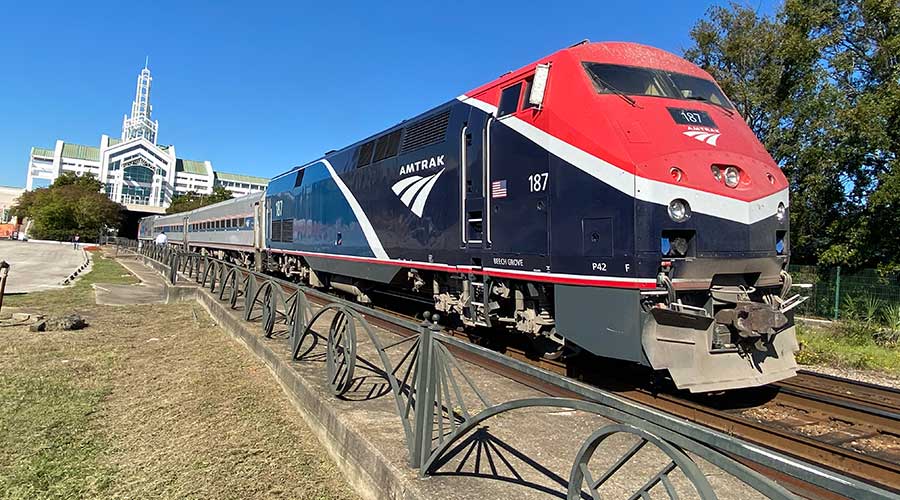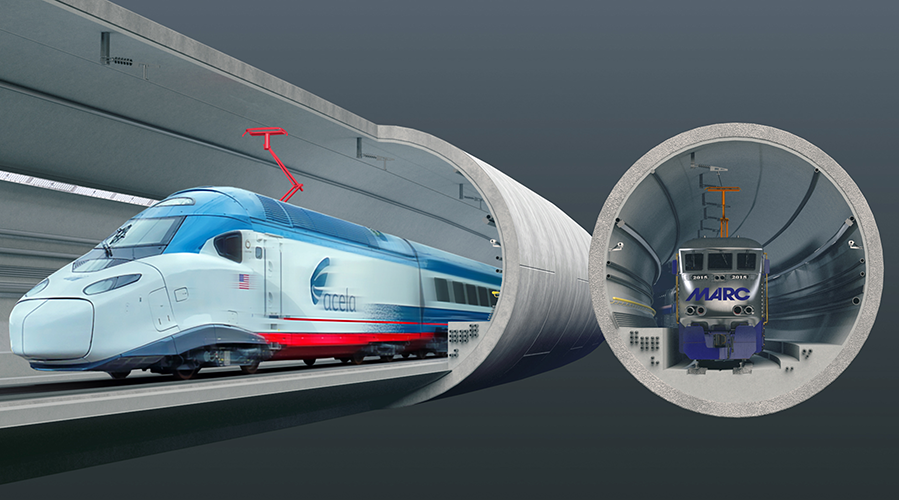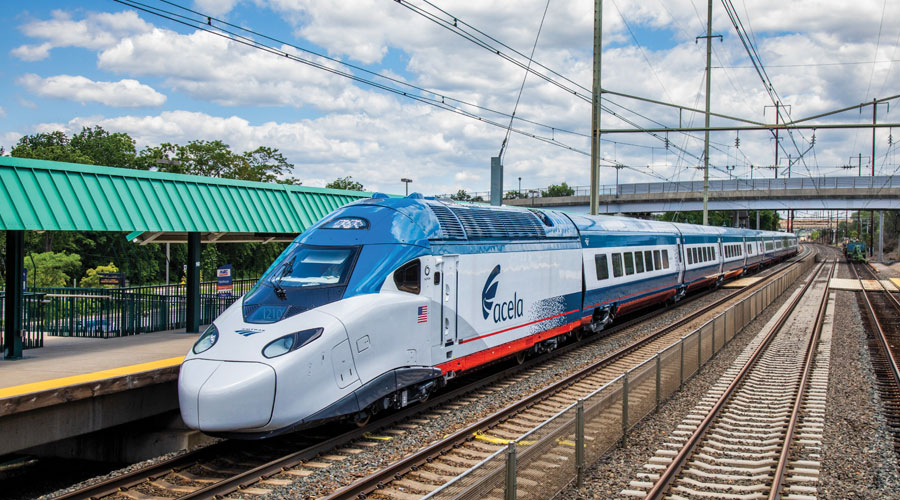Stay updated on news, articles and information for the rail industry
December 2022
Rail News: Amtrak
Flush with new funding opportunities, Amtrak preps for growth
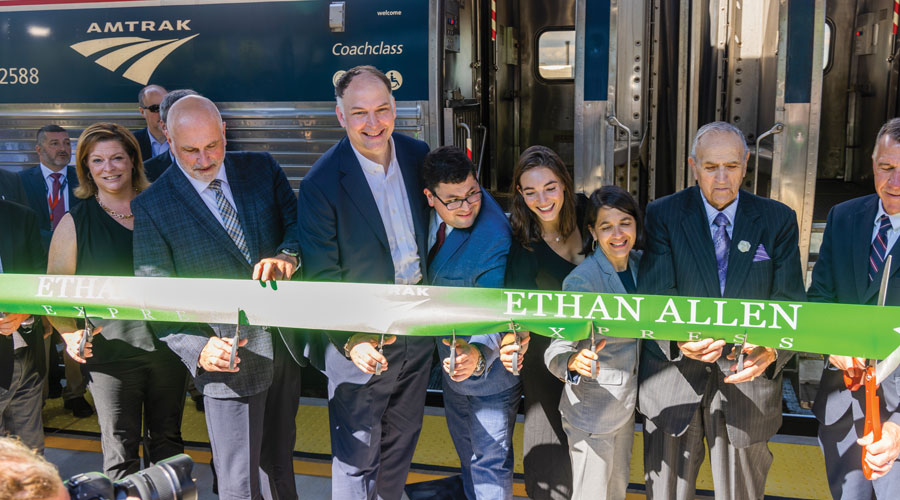
By Julie Sneider, Senior Associate Editor
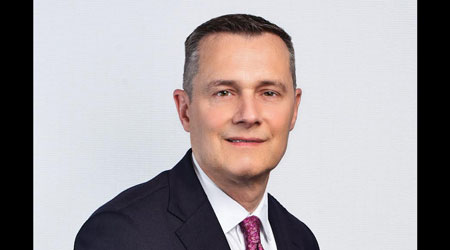
In 2021, Amtrak executives spent most of the railroad's 50th anniversary year promoting a 15-year strategy for expansion that would connect dozens of cities — up to 160 communities — to new Amtrak service.
Dubbed "Amtrak Connects US," the plan hung in the balance until President Joe Biden in November 2021 signed the Infrastructure Investment and Jobs Act (IIJA), the $1.2 trillion, five-year surface transportation reauthorization legislation. The law calls for $66 billion in funding for rail that could help pave the way for new intercity routes.
Today, Amtrak — flush with new federal funding opportunities — is juggling multiple priorities, including preparing to offer service in new rail corridors; upgrading aging assets; recovering ridership lost during the pandemic; addressing customer service problems; and recruiting and retaining enough workers to run the trains now and into the future.
"All these things take time," says Amtrak President Roger Harris, who was promoted to his post in June after serving as the railroad’s chief commercial officer since April 2019. "Having the money released [through the IIJA] is probably the biggest piece of work ahead of us."
Since late last year, Amtrak officials have been working on securing billions in grant funds, including those that could help pay for intercity passenger-rail expansion through the new Corridor Identification and Development Program, which was created under the IIJA. The Federal Railroad Administration has begun the process that will eventually identify and establish new rail corridors through which Amtrak could expand rail service. Since mid-May, the FRA has been collecting “expressions of interest” from states, regions, local governments and other entities that want to be considered for future passenger-rail service.
Before Dec. 31, the FRA will publish a notice seeking formal proposals for the Corridor ID program. After evaluating those proposals, the FRA will help develop selected corridors and prioritize those projects for federal funding, an FRA spokesman said in an email.
Amtrak is being consulted as the process advances, according to Harris.
"We are actively engaged with the FRA, so they solicit our input and advice on a lot of these programs," he says. "We also work with the states and other local entities who are the sponsors of the expressions of interest. But at the end of the day, it’s really up to the FRA" to determine where the new corridors will be.
On the horizon: Gulf Coast service
One corridor where Amtrak already plans to start offering service is along the Gulf Coast between New Orleans and Mobile, Alabama. Amtrak trains haven’t operated there since Hurricane Katrina roared through in 2005. The Southern Rail Commission and other backers of restoring Amtrak service say it would help attract new business and economic development in the Gulf Coast region. Currently, Amtrak plans to run two trains daily between the cities.
But opposition from CSX, Norfolk Southern Railway and the Alabama State Port Authority has delayed Amtrak’s plan. The Class Is, which own the track that Amtrak trains would use, have said the passenger service would interfere with freight trains using the line.
The Surface Transportation Board was brought in to resolve the dispute, but before it could rule on the matter, Amtrak, the freight railroads and the port authority announced on Nov. 22 a settlement agreement. Although details weren’t revealed, STB Chairman Martin Oberman said the agreement will hasten the start of passenger-rail service along the coast.
Prior to the settlement announcement, Harris said: "We would like to begin serving the Gulf Coast market as soon as possible in this fiscal year," which began Oct. 1.
While Amtrak executives keep their eyes on potential new routes, they’re also focused on improving existing business, including rebuilding ridership to pre-pandemic levels.
In general, demand for Amtrak service remains strongest in the Northeast. However, commuter ridership has been slower to return, as employers continue to offer hybrid or flexible work schedules. Ridership for commuting or business purposes is at about 60% of pre-COVID levels, Harris says.
At the same time, Amtrak officials have noticed an uptick in new rail travelers.
"For at least a year now, we’ve seen about a third of our ridership is new customers, or people who we haven’t known before in any of our data in history," Harris says. “Those demographic trends have helped reinforce our business, so it’s incumbent on us to work with our state partners to develop proposals on how the growth of those state corridor programs can help reinforce that lifestyle change. I think it’s a healthy trend in terms of sustainability and growth."
Offering sales on ticket prices and special travel packages, as well as restoring train routes suspended due to the pandemic, helped Amtrak start to get ridership back on track. Through the first nine months of fiscal-year 2022, the railroad logged total ridership of 16.7 million, up from 7 million during the same period in FY2021. Ridership in the Northeast Corridor rose to 6.5 million from 2.4 million; on long-distance routes, ridership climbed to 2.6 million from 1.4 million; and on state-sponsored routes, ridership grew to 7.7 million from 3.2 million during the period.
[Editor's note: On Nov. 29, Amtrak announced it provided 22.9 million customer trips, including 7 million first trips by new riders, from Oct. 1, 2021, and Sept. 30, 2022.]
In response to changing travel patterns, Amtrak is re-examining its train schedules based on demand. As part of that effort, it also has changed its ticket management system to be “far more responsive to what’s going on now and last week, and not last year,” Harris says.
Hiring is ongoing
Amtrak’s pandemic recovery also depends on recruiting and retaining a workforce big enough to handle existing and future service. Early in the pandemic, Amtrak stopped hiring staff and furloughed some employees after ridership plunged more than 95%. Once ridership started to recover, Amtrak launched a hiring campaign for train crew, mechanics, onboard service staff and some management positions.
Over the past 12 months, the railroad has recruited 3,700 new workers in part by offering competitive wages and hiring bonuses. At the same time, Amtrak — like other employers — has continued to experience the so-called "Great Resignation," with employees retiring or moving on for other reasons.
"We have an ongoing need for employees," says Harris. "Another big employment area that we’ve been recruiting for is track maintenance because we have a lot of money coming out of the IIJA that will go toward track work and improvement projects. We’re working very hard to upgrade the state of good repair on the Northeast Corridor … so our track crew engineering team is hiring on a very big scale."
Still, the workforce ramp-up period takes longer in rail than in other industries due to federally required training requirements. And while many new hires are needed just to maintain existing service, the challenge of quickly increasing the workforce is taking time. As a result, Amtrak has had to temporarily suspend service on several lines due to ongoing staff shortages.
Moreover, the staff shortage is hurting Amtrak’s efforts to improve service from the passenger perspective, according to Rail Passengers Association President and CEO Jim Mathews.
"They really need more people to provide the customer service that passengers expect and they are not able to hire people quickly enough to do that," Mathews says.
As an example, he cited Amtrak’s customer-service debacle on the Wolverine route in early October, when a locomotive mechanical problem snowballed into a nightmarish 13-hour delay for riders traveling between Ann Arbor, Michigan, and Chicago.
"We heard stories all summer long about disrupted trips and passengers being treated poorly, and this [Wolverine case] is a sad continuation of that trend," says Mathews.
An apology to unhappy riders
For Amtrak’s part, Harris acknowledged that the railroad didn’t handle the Wolverine situation well. In a letter to Wolverine passengers, he expressed a “heartfelt apology” and offered ticket refunds, reimbursement of passenger expenses incurred while getting to their final destinations, and a $100 credit toward future travel. Since then, Amtrak also revised its procedures for responding to service disruptions with better decision-making and customer communication.
The need for better customer service will intensify as demand for new service grows, Mathews believes. But exactly when and where Amtrak will add to its network will depend on another factor: political and financial support from states that would share in the cost for that service.
"You have to have local and state support to be considered for passenger-rail service," Mathews explains. "For example, there are communities in Arizona that are champing at the bit for Amtrak to come in. The demographics and the economics there scream out for it, but Arizona as a state hasn’t supported it."
Although the Corridor ID program will be the primary mechanism through which the FRA will support intercity passenger-rail corridor development, the IIJA also created the Interstate Rail Compact Grant Program, which will provide financial assistance to states that set up interstate rail compacts to advance passenger-rail service. It also requires the FRA to conduct a study of Amtrak long-distance service along discontinued routes or those with nondaily long-distance service.
Passenger-rail advocates in some parts of the country already are far along in lining up the support they need to make their case for new Amtrak service. Among them are the Big Sky Passenger Rail Authority in southern Montana and the Front Range Passenger Rail District in Colorado.
Building a case for passenger rail
Front Range district officials hope to establish a passenger-rail line along the Interstate-25 corridor between Pueblo and Fort Collins, then connect it with Amtrak’s Southwest Chief route and potentially into Wyoming and New Mexico. In June, Colorado Gov. Jared Polis signed a law to provide nearly $9 million in funding for the route’s planning and development. The district’s board held its first meeting this summer; nonvoting members include representatives of Amtrak, Union Pacific Railroad and BNSF Railway Co.
Although the district is new, it succeeds the Front Range Passenger Rail Commission that spent years securing bipartisan political support for the proposed route along the I-25 corridor, according to Front Range District Chairman Jim Souby. District officials are among those that have expressed interest to the FRA in becoming a new rail corridor.
Meanwhile, the Big Sky authority was officially established in 2020, but people associated with it have been working on restoring a long-distance Amtrak route through the greater Northwest after part of its North Coast Limited/Hiawatha line from Chicago to Seattle was cancelled in 1979. Ending that connection severed access to passenger-rail service to the largest cities in Montana and North Dakota, as well as smaller towns in between, says David Strohmaier, the authority’s chairman.
If restored, the new Big Sky line would cover southern Montana as part of a larger route from Chicago, running through the Twin Cities and across southern North Dakota into Montana.
The authority is pursuing its plan through both the FRA’s upcoming study of long-distance routes, as well as through the Corridor ID program. To advance their proposal, Big Sky officials sought the support of Amtrak, BNSF (whose freight-rail track would host the new passenger-rail service), state transportation officials, county and local governments, and three Tribal Nations.
To that end, Strohmaier hopes Big Sky can serve as a model for other communities hoping to attract Amtrak trains to their towns.
"We’ve made more progress in the last two years than we have in the first 40, and I think passenger-rail service is finally within our grasp," Strohmaier says.
Email comments or questions to julie.sneider@tradepress.com.
Keywords
Browse articles on Amtrak Amtrak Connects US Roger Harris Stephen Gardner Amtrak expansion plan Gulf Coast passenger-rail service intercity passenger rail train ridership trends IIJA federal funding Rail Passengers Association Jim Mathews Big Sky Passenger Rail Authority Front Range Passenger Rail District FRA Class IsContact Progressive Railroading editorial staff.


 2025 MOW Spending Report: Passenger-rail programs
2025 MOW Spending Report: Passenger-rail programs
 Gardner steps down as Amtrak CEO
Gardner steps down as Amtrak CEO
 Guest comment: Oliver Wyman’s David Hunt
Guest comment: Oliver Wyman’s David Hunt
 Women of Influence in Rail eBook
Women of Influence in Rail eBook
 railPrime
railPrime






